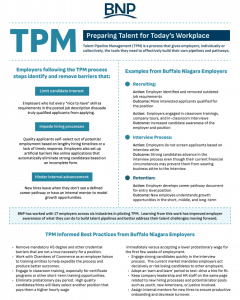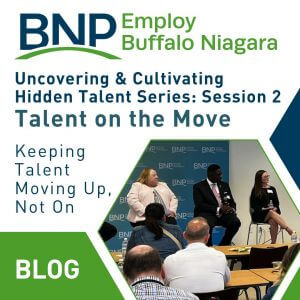TPM : Preparing Talent for Today’s Workplace
Talent Pipeline Management (TPM) is a process that gives employers, individually or collectively, the tools they need to effectively build their own pipelines and pathways.
Developed by the U.S Chamber of Commerce, TPM is designed to help employers identify and remove barriers that:
- Limit candidate interest
- Impede hiring processes
- Hinder internal advancement
The BNP has worked with 17 employers across six industries in piloting TPM. Learning from this work has improved employer awareness of what they can do to address talent pipelines and better address their talent challenges moving forward.
To learn more about TPM:
Connect with a member of the BNP Talent Navigator team to see if TPM is right for you.
From The Blog
Navigating Shifting Workplace Norms: Panel Discussion
The workplace landscape is evolving at an unprecedented pace, and staying ahead of the curve is crucial for businesses aiming to attract and retain top talent. In the final session of our 4-part Hidden Talent series, we brought together a panel of industry experts to shed light on these critical shifts and provide actionable insights for employers.
How the U.S. Is Closing the Door to Top Talent
The BNP organized a Capital Conversations event as part of our Government Affairs series to examine the workings of the H-1B program and explore potential reforms that could strengthen our regional economy.
Successfully Engaging Non-Traditional Talent
Uncovering and Cultivating Hidden Talent Series: Session 3 – Talent Hiding in Plain Sight
Keeping talent from moving on, by creating pathways to move up
Uncovering and Cultivating Hidden Talent Series: Session 2 – Talent on the Move
Keeping and growing talent is key to any high-performing organization. But what can you do to keep employees from walking out your door for new opportunities?





